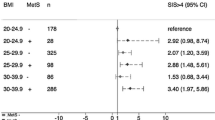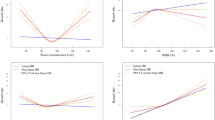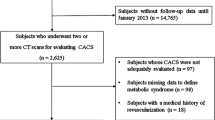Abstract
The inverse relationship between obesity and adverse cardiovascular outcomes has been coined the ‘obesity-paradox’. We sought to determine the relationship between measures of obesity [body mass index (BMI), body surface area (BSA) and body fat percentage (BF%)] and coronary artery calcification (CAC). We retrospectively analyzed patients who underwent CAC using the Agatston score. Baseline demographics were collected and BMI, BSA and BF% were calculated. A two-stage regression modeling approach was used to evaluate the association between BMI, BSA, BF% and Agatston score. Of the 6661 patients [mean age = 57.1 ± 10.8 years, men = 54.3 %, median Agatston score = 14 (0, 163)], 0.1 % were underweight, 21.3 % had normal BMI, 39.1 % were overweight and 39.4 % were obese. The mean BMI, BSA and BF% were 29.6 ± 6.1 kg/m2, 1.97 ± 0.25 m2 and 37 ± 10 %, respectively. There was an independent association between the presence of CAC and BMI (5 kg/m2 increments) (OR 1.05, CI 1.00–1.11, P = 0.038) and BF% (OR 2.38, CI 1.05–5.41, P = 0.038). Neither BMI categories nor large BSA independently predicted the presence of CAC. BF% predicted the extent of CAC in men but not in women, and higher BF% was associated with higher category of CAC severity in men only. BMI and BF% were independent predictors of the presence of CAC. BF% was associated with the extent of CAC and higher BF% was associated with higher category of CAC severity in men only. These results suggest that further study is needed to better understand the obesity-paradox.
Similar content being viewed by others
Abbreviations
- BF%:
-
Body fat percentage
- BMI:
-
Body mass index
- BSA:
-
Body surface area
- CAC:
-
Coronary artery calcification
- CAD:
-
Coronary artery disease
- CI:
-
Confidence interval
- CTA:
-
Computed tomographic coronary angiography
- EAT:
-
Epicardial adipose tissue
- OR:
-
Odds ratio
- SD:
-
Standard deviation
- WHR:
-
Waist-hip ratio (WHR)
- WHO:
-
World Health Organization
- VAT:
-
Visceral adipose tissue
References
Flegal KM, Carroll MD, Ogden CL, Johnson CL (2002) Prevalence and trends in obesity among us adults. JAMA 288:1723–1727
World Health Organization (2012) Obesity and overweight. www.who.int/mediacentere/factsheets/fs311/en/. Accessed 1 Jan 2013
Krauss RM, Winston M, Fletcher BJ, Grundy SM (1998) Obesity: impact on cardiovascular disease. Circulation 98:1472–1476
Rimm EB, Stampfer MJ, Giovannucci E, Ascherio A, Spiegelman D, Colditz GA, Willett WC (1995) Body size and fat distribution as predictors of coronary heart disease among middle-aged and older US men. Am J Epidemiol 141:1117–1127
Hubert HB, Feinleib M, McNamara PM, Castelli WP (1983) Obesity as an independent risk factor for cardiovascular disease: a 26-year follow-up of participants in the Framingham Heart Study. Circulation 67:968–977
Panagiotakos DB, Pitsavos C, Yannakoulia M, Chrysohoou C, Stefanadis C (2005) The implication of obesity and central fat on markers of chronic inflammation: the ATTICA study. Atherosclerosis 183:308–315
Romero-Corral A, Montori VM, Somers VK, Korinek J, Thomas RJ, Allison TG, Mookadam F, Lopez-Jimenez F (2006) Association of bodyweight with total mortality and with cardiovascular events in coronary artery disease: a systematic review of cohort studies. Lancet 368:666–678
Lavie CJ, Milani RV, Artham SM, Patel DA, Ventura HO (2009) The obesity paradox, weight loss, and coronary disease. Am J Med 122:1106–1114
Lavie CJ, Milani RV, Ventura HO (2009) Obesity and Cardiovascular disease: risk factor, paradox, and impact of weight loss. J Am Coll Cardiol 53:1925–1932
Pletcher MJ, Tice JA, Pignone M, Browner WS (2004) Using the coronary artery calcium score to predict coronary heart disease events: a systematic review and meta-analysis. Arch Intern Med 164:1285–1292
Kondos GT, Hoff JA, Sevrukov A, Daviglus ML, Garside DB, Devries SS, Chomka EV, Liu K (2003) Electron-beam tomography coronary artery calcium and cardiac events: a 37-month follow-up of 5635 initially asymptomatic low- to intermediate-risk adults. Circulation 107:2571–2576
Mosteller RD (1987) Simplified calculation of body-surface area. N Engl J Med 317:1098
Deurenberg P, Weststrate JA, Seidell JC (1991) Body mass index as a measure of body fatness: age-and sex-specific prediction formulas. Br J Nutr 65:105–114
Agatston AS, Janowitz WR, Hildner FJ, Zusmer NR, Viamonte M Jr, Detrano R (1990) Quantification of coronary artery calcium using ultrafast computed tomography. J Am Coll Cardiol 15:827–832
Roy SK, Zeb I, Kadakia J, Li D, Budoff MJ (2012) Body surface area is a predictor of coronary artery calcium, whereas body mass index is not. Coron Artery Dis 23:113–117
Labounty TM, Gomez MJ, Achenbach S, Al-Mallah M, Berman DS, Budoff MJ et al (2013) Body mass index and the prevalence, severity and risk of coronary artery disease: an international multicenter study of 13,874 patients. Eur Heart J Cardiovasc Imaging 14:456–463
Burke GL, Bertoni AG, Shea S (2008) The impact of obesity on cardiovascular disease risk factors and subclinical vascular disease: the multi-ethnic study of atherosclerosis. Arch Intern Med 168:928–935
Niraj A, Pradahan J, Fakhry H, Veeranna V, Afonso L (2007) Severity of coronary artery disease in obese patients undergoing coronary angiography: “obesity paradox” revisited. Clin Cardiol 30:391–396
Whitlock G, Lewington S, Sherliker P, Clarke R, Emberson J, Halsey J, Qizilbash N, Collins R, Peto R (2009) Body-mass index and cause-specific mortality in 900,000 adults: collaborative analyses of 57 prospective studies. Lancet 373:1083–1096
Rabkin SW, Mathewson FA, Hsu PH (1977) Relation of body weight to development of ischemic heart disease in a cohort of young North American men after a 26 year observation period: the Manitoba Study. Am J Cardiol 39:452–458
Calle EE, Thun MJ, Petrelli JM, Rodriguez C, Heath CW (1999) Body-mass index and mortality in a prospective cohort of US Adults. N Engl J Med 341:1097–1105
Berrington de Gonzalez A, Hartge P, Cerhan JR, Flint AJ, Hannan L, MacInnis RJ et al (2010) Body-mass index and mortality among 1.46 million white adults. N Engl J Med 363:2211–2219
Horwich TB, Fonarow GC, Hamilton MA, MacLellan WR, Woo MA, Tillisch JH (2001) The relationship between obesity and mortality in patients with heart failure. J Am Coll Cardiol 38:789–795
Lavie CJ, Osman AF, Milani RV, Mehra MR (2003) Body composition and prognosis in chronic systolic heart failure: the obesity paradox. Am J Cardiol 91:891–894
Oreopoulos A, Padwal R, Kalantar-Zadeh K, Fonarow GC, Norris CM, McAlister FA (2008) Body mass index and mortality in heart failure: a meta-analysis. Am Heart J 156:13–22
Lavie CJ, Alpert MA, Arena R, Mehra MR, Milani RV, Ventura HO (2013) Impact of obesity and the obesity paradox on prevalence and prognosis in heart-failure. JACC Heart Fail 1:93–102
Romero-Corral A, Somers VK, Sierra-Johnson J, Jensen MD, Thomas RJ, Squires RW, Allison TG, Korinek J, Lopez-Jimenez F (2007) Diagnostic performance of body mass index to detect obesity in patients with coronary artery disease. Eur Heart J 28:2087–2093
Romero-Corral A, Somers VK, Sierra-Johnson J, Thomas RJ, Collazo-Clavell ML, Korinek J, Allison TG, Batsis JA, Sert-Kuniyoshi FH, Lopez-Jimenez F (2008) Accuracy of body mass index in diagnosing obesity in the adult general population. Int J Obes 32:959–966
Kopelman PG (2000) Obesity as a medical problem. Nature 404:635–643
Janssen I, Heymsfield SB, Allison DB, Kotler DP, Ross R (2002) Body mass index and waist circumference independently contribute to the prediction of nonabdominal, abdominal subcutaneous, and visceral fat. Am J Clin Nutr 75:683–688
Rothman KJ (2008) BMI-related errors in the measurement of obesity. Int J Obes 32:S56–S59
Canoy D, Boekholdt SM, Wareham N, Luben R, Welch A, Bingham S, Buchan I, Day N, Khaw KT (2007) Body fat distribution and risk of coronary heart disease in men and women in the European prospective investigation into cancer and nutrition in norfolk cohort: a population-based prospective study. Circulation 116:2933–2943
Coutinho T, Goel K, Correa de Sa D, Kragelund C, Kanaya AM, Zeller M et al (2011) Central obesity and survival in subjects with coronary artery disease: a systematic review of the literature and collaborative analysis with individual subject data. J Am Coll Cardiol 57:1877–1886
Despres JP (2012) Body fat distribution and risk of cardiovascular disease: an update. Circulation 126:1301–1313
Iacobellis G, Ribaudo MC, Assael F, Vecci E, Tiberti C, Zappaterreno A, Di Mario U, Leonetti F (2003) Echocardiographic epicardial adipose tissue is related to anthropometric and clinical parameters of metabolic syndrome: a new indicator of cardiovascular risk. J Clin Endocrinol Metab 88:5163–5168
Duflou J, Virmani R, Rabin I, Burke A, Farb A, Smialek J (1995) Sudden death as a result of heart disease in morbid obesity. Am Heart J 130:306–313
Alexopoulos N, McLean DS, Janik M, Arepalli CD, Stillman AE, Raggi P (2010) Epicardial adipose tissue and coronary artery plaque characteristics. Atherosclerosis 210:150–154
Mahabadi AA, Berg MH, Lehmann N, Kalsch H, Bauer M, Kara K, Dragano N, Moebus S, Jockel KH, Erbel R, Mohlenkamp S (2013) Association of epicardial fat with cardiovascular risk factors and incident myocardial infarction in the general population: the Heinz Nixdorf Recall Study. J Am Coll Cardiol 61:1388–1395
Mazurek T, Zhang L, Zalewski A, Mannion JD, Diehl JT, Arafat H, Sarov-Blat L, O’Brien S, Keiper EA, Johnson AG, Martin J, Goldstein BJ, Shi Y (2003) Human epicardial adipose tissue is a source of inflammatory mediators. Circulation 108:2460–2466
Rosito GA, Massaro JM, Hoffmann U, Ruberg FL, Mahabadi AA, Vasan RS, O’Donnell CJ, Fox CS (2008) Pericardial fat, visceral abdominal fat, cardiovascular disease risk factors, and vascular calcification in a community-based sample: the Framingham Heart Study. Circulation 117:605–613
McClelland RL, Chung H, Detrano R, Post W, Kronmal RA (2006) Distribution of coronary artery calcium by race, gender, and age results from the multi-ethnic study of atherosclerosis (MESA). Circulation 113:30–37
Conflict of interest
Benjamin Chow holds the Saul and Edna Goldfarb Chair in Cardiac Imaging Research. He receives research support from GE Healthcare and educational support from TeraRecon Inc. No other authors have conflicts of interest to disclose.
Author information
Authors and Affiliations
Corresponding author
Rights and permissions
About this article
Cite this article
Aljizeeri, A., Coutinho, T., Pen, A. et al. Obesity and coronary artery calcification: Can it explain the obesity-paradox?. Int J Cardiovasc Imaging 31, 1063–1070 (2015). https://doi.org/10.1007/s10554-015-0643-9
Received:
Accepted:
Published:
Issue Date:
DOI: https://doi.org/10.1007/s10554-015-0643-9




